Alex Watts's Blog, page 9
October 23, 2012
Cambodia: ‘King’s Face Appears On The Moon’

I got back to Cambodia a few days after King
Sihanouk’s death. The country was holding seven days of mourning to celebrate
his life. It was easy to be cynical at a time like this. Much of the media have
portrayed him as a Khmer Rouge puppet who stood by when his people were murdered
in one of the bloodiest genocides the world has ever seen.
He certainly moved with the political tide from peacefully
obtaining independence from France to assisting Pol Pot’s rise to power, and
has his own place in the Guinness World Records as having a greater variety of
offices than any other politician. But the people were genuinely moved by his
death, and there were shrines to him everywhere and flags at half-mast across Phnom Penh .
The taxi driver taking me from the airport to the
Central Market sighed as the traffic came to another stand-still. “Everyone
come to celebrate the King,” he said. “He was a good man. The people are sad.
His son not so popular.”

I’d been warned the bars had been closed for seven
days but it didn’t seem to have stretched to the neon bars on Street 51 or
anywhere else I could see. The only sign of enforcement was the absence of
music.
As I walked further on, I kept seeing huddles of
people gazing upwards, pointing and chattering. I looked up at a building, half
expecting someone to be up there preparing to jump. But there was nothing. Just
a sickle moon with a faint yellow halo round it.
I carried on walking. More people were gazing
upwards. I asked what they were looking at but they just pointed and looked
slightly embarrassed. The only ones not looking were the gang of tuk tuk
drivers on the corner.
“Hey! Hey sir! Hello, motorbike?” they shouted. I’d
forgotten about the relentless hisses and calls from the taxi drivers. It didn’t
matter if you walked past six of them, politely declining each time, the
seventh would still ask anyway. They had mouths to feed. I was determined to
keep my cool this time in Asia. I was determined to remember how it all worked.
The next morning, I found out what all the staring
had been about. The Cambodian social media was full of it, but opinion was heavily
divided. Was it really the face of the King or just the crescent-shaped moon
staring down at them? From the photos it looked unlikely, but I knew from
staring at the moon, and its cracks and shadows, or cloud patterns, after a
while you can see anything you want.
And for ordinary Cambodians, what they wanted in
their time of grief was to stare once more at their former King and hope it was
a sign of better times to come. Rather than the increased power of the
politicians they’d been left with.

I walked down to the Royal Palace, where the King’s
body would be kept for the next three months, embalmed for all to see. Thousands
had gathered outside, praying and buying lotus flowers, as the street kids
mingled between them begging for hand-outs.
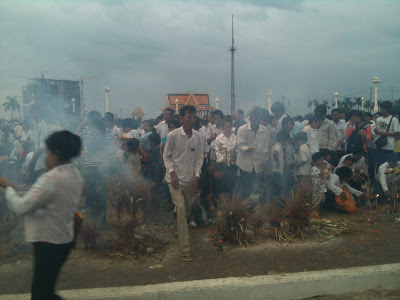
The air was thick with incense smoke. They had given
up burning the joss sticks individually and had set fire to bundles, pouring
water on from time to time to control the flames. Tears were streaming down the
mourners’ faces as the perfumed smoke billowed towards them, filling the
dimming light with a spectral haze.

I returned to my hotel as the heavens opened and
waited for the monsoon to stop. Then I waded across the road, two feet deep in
water. The stench of the sewers was overpowering. The tuk tuks were holding up
a computer print-out of a photo one of them claimed to have taken. One of them
held a 10,000 riel note next to it, showing King Sihanouk’s face. They kept pointing
excitedly and were still going on about it five minutes later when I returned
with my iPhone to take a picture.
They might have been half hysterical, they might
have been on the pipes, they might have doctored the photo, but as they held
the note closer, there was a resemblance. I pointed to the eye shadows on the
note, and nodded my head with the rest of them, and then pointed at the
corresponding shadows on the moon. It was the King - the man on the moon. I even
half believed them.
I waded across the road back to the hotel. The girl
on reception was walking up the stairs. “Did you see the moon?” I asked her.
She stopped and shrugged. “I tried...I looked for five minutes, but I couldn’t
see the King.”
Published on October 23, 2012 02:59
October 21, 2012
Bangkok: Water Spinach And War
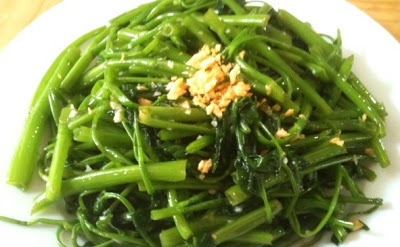
When I land in Bangkok on my way to Cambodia , the
first thing that hits me is the stifling heat and the smell of fish sauce as I
emerge from my airport taxi into the warrens of Thailand’s biggest city. I sit
down at a street stall on a Saturday afternoon, an hour before sunset, and
order one of my favourite Asian meals of chicken noodle soup , but they haven’t
got it.
“Pork!” snaps the noodle cook, jabbing a finger at
her spidery-scrawled sign. She doesn’t do anything else, and nor does her
husband, who’s crouched at the back, busy prepping a grimy tub of water spinach .
I perch on a stool by the roadside, my knees up to
my ears. My bowl arrives in seconds. There are a few slices of pork, tandoori red
around the edges, a scattering of sliced spring onion greens, a few slivers of
crisped garlic, golden brown in colour, angel hair noodles, and beansprouts.
The nod to vitamins is the single piece of kale that somehow found its way into
my bowl on the back of a spoon.
Four pots of garnishes are thrust at me - pounded
dried chillies with what looks disconcertingly like a pube sticking out, an explosive
chilli vinegar, sugar, and crushed peanuts. A bottle of fish sauce, toothpicks,
and a plastic drum of napkins complete the street food decor.
Except I was wrong about the lack of greenery. As I delve
deeper into the last loop of noodles, a piece of water spinach appears in the
bowl. For some reason, I think of a story I heard about the Vietnam War , or
American War if you live in Vietnam. About how the Americans were literally
hoist with their own petards when they bombed the vastly underequipped but
ruthlessly cunning Viet Cong making their way from north to south through the
mountain passes of the Ho Chi Minh trail .
The passes were marked and American bombers flew over
blowing holes in the mountainside. The men with their shoes made from old truck
tyres were slowed but still they came, clearing the rubble and finding other
trails. And as the monsoon rains started, the bomb craters became pools.
Messages were passed and the next group of Viet Cong
brought live fish with them and stocked the pools, and the fish slowly multiplied
in their new mountain home. Then they planted water spinach cuttings, which
quickly spread - long, hollow stalks with a few leaves at the top, delicious when
fried with garlic and fish sauce. As each unit of National Liberation Front
militia arrived, they found pools full of fish and swamp cabbage to feed them.
I bite into the tube and imagine those fighters
sitting around a pot, sleeping off their evening feast provided by the bombs
that were meant to kill them. I sip away at my ice-cold Singh beer as the last
of the light fades, the car lights come on, and Bangkok puts on its neon
clothes and waits for the hustle and shrieks of night.
The noodle cook sends her young son to fetch more
beer from a nearby store. Outside it is a newspaper stand packed full of today’s
editions of German and British tabloids - they know their tourist market in
Bangkok. At the bottom is The Sun. “Pleb And Buried” is the headline. “Cop slur
minister quits at last.” London seems a long way away.
MORE: Vietnam: Remnants From A Stricken Land
Published on October 21, 2012 12:07
October 9, 2012
Cheesed Off: Complaint Letter To A London Cheese Shop
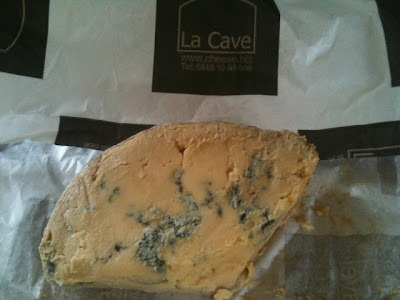
Letter to La Cave a Fromage - a "wonderful cheese retailer" in London ...
Dear Sir/Madam,
I am
writing to say how disappointed I am with a cheese I bought from your stall at
the Thame Food Festival. It was particularly annoying
because I’d read somewhere that you were decent cheesemongers and
only sold the finest cheeses, and I’d gone there especially to sample your
wares and restock my cheese selection for a supper I was hosting that night.
This
certainly wasn't the case with the slab of Somerset Blue I had the
misfortune to purchase. In short, it tasted and smelled of pear-flavoured ammonia,
giving it a disconcerting whiff somewhere between nail varnish and a skate that’s
been left in a plastic bag at the back of a broken fridge for two years. Even
the wonderful crackers I'd purchased for the occasion couldn't cut the foul
flavour.
Let me
give you the background. When I examined the cheeses on display at your stall,
a very chipper chap quickly directed me to your Somerset Blue - which he
described, quite wrongly, as a “luvva-ly stilton we make ourselves”. It certainly looked
mature, but I had no idea how much until I was unfortunate enough to try a
mouthful. I should have been suspicious because I wasn't offered a sample to
try, but at the reassuringly expensive prices foodie outfits like yours confidently
charge these days, there is usually an assumed trust between purchaser and fleecer.
Instead,
your cheese chap quickly got down to business and no sooner had his back been
turned for a second to weigh a slab (was it a switch?), he said: "I tell
you what mate, as it's the end of the day, you can have the whole piece for £6."
He said it in such a cheery, and as I know now underhand way, that it
seemed like he was doing me a favour.
How he
wrapped it so tightly that the putrid smell of ammonia didn't seep out into the
car, or poison ducks in passing villages, I have no idea. But as soon as I
unwrapped it at home, the house was filled with an unearthly stench that reminded
me of prahok , a fermented fish paste made in Cambodia, that had been soaked
in tramps’ urine for a few days.
Words are
useless for occasions like these, and I really can’t do justice to how repulsive
it was. In fact, the unpleasantness of the smell was only matched by the revoltingness
of the taste I had the misfortune to experience before I promptly spat
the offending cracker out. When I checked with a cheese expert friend, a curd nerd if you will, he said it was obvious the cheese hadn't been stored properly,
and the best place for it was the bin. Or perhaps an underground nuclear bunker
designed for storing such biological abominations?
It is
quite obvious that your cheese chap knew quite well how revolting the Somerset
Blue was in the invidious tactics he used in disposing of his repulsive produce.
But I would expect more from a supplier that immodestly, and unattributably,
hails itself as a "wonderful cheese retailer".
On your
website, you add: "Cheese is simple, it is mainly made of milk, but, at
the same time complex..." Perhaps you mean toxic? Having re-read it a
couple of times, you then really do go on to say: "Cheese is totally
integrated in nature and based on secular savoir faire and human
skills. We simply want to keep up with traditions and bring them into our
modern world."
Well, you
have certainly done the latter, and created something so contemporaneously hazardous,
it warrants its own page in any good modern warfare manual. As for secular savoir faire, I imagine if Saddam
Hussein was still around, it’s the sort of thing he’d use to terrorise the
Kurds. Or perhaps even he wouldn’t have gone that far?
Yours
sincerely,
Alex
Watts
Published on October 09, 2012 04:32
August 30, 2012
When Did Cooking Disappear Up Its Own Arse?
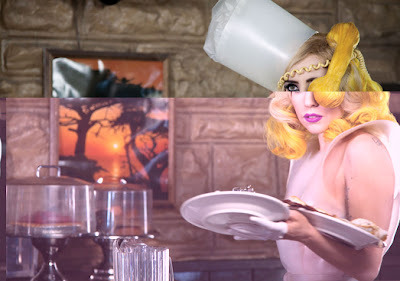
I finally persuaded a friend to lend me his vintage copy
of The Art Of Simple French Cookery by the superbly named Alexander Watt, a
notorious gourmet who spent much of his life lounging around in bistros - a
name he tells us originated around the fall of Napoleon, when ravenous Russians
encamped in Paris would wander around shouting “bistro, bistro!” (meaning “quick,
quick” in their nasal tongue) as they entered cafes looking for something to
eat.
No doubt beginning his day with pastis, moving on to
red wine, and then finishing the night on brandy, Watt would gorge himself on bistro
classics such as poularde Marie-Louise, boeuf en gelee, rognons a la moutarde,
gibelotte de lapin, and always a plate of seasonal cheeses.
The accounts of his “gastronomic peregrinations” are
a joy to read, as is his book, Paris Bistro Cookery, which adjoins the back of The
Art Of Simple French Cookery like an upside down Siamese twin. As you flick
through the pages, noting the splendid simplicity of the dishes, you can picture
Watt swaying in the doorway of tiny Parisian kitchens, disrupting service as he
scrawls into a grease-spattered notebook.
In one introduction, he quotes Alexandre Dumaine,
the celebrated proprietor of the Hotel de la Cote d’Or, at Saulieu, and at the
time of writing in the 1950s, a man widely considered to be the greatest chef
in France, remarking that “the simplest dishes are often the most difficult to
prepare to perfection”. And it got me thinking about when modern cooking
finally disappeared, irretrievably, up its own arse.
Talk to chefs and food writers now and they’re obsessed
with 480-hour slow-braised pork, moss infusions, locally-picked weeds,
ingredient reversals, baby vegetable purees, quintuple-cooked chips, and
anything else they can jam into a sous vide bath. When they’re not boring you
to death about acidifier particle accelerators or the optimum water bath temperature
for mackerel, they’re waffling on about their new £2,000 Swiss gelato machine,
or their latest experiment with meat glue.
“I’ve been transglutaminasing duck skin on to
chicken legs - it’s wonderful for the barbecue,” I honestly heard one food nerd
say the other day.
It was at a highly pretentious food convention I’d
been invited along to. Everyone had to bring something. There were the
predictable, umami-filled burgers, stacked full of shaved ambergris, sun-crisped
tomatoes and parmesan, and vac-packed offerings that had been poaching away since
Christmas. All the vegetables were hand cut, the fruit hand picked, there were
twin shots of soup, and trifles with fancy labels boasting of Amontillado
sherry. The bread was savoury enriched or griddled or both, the cheese shaved,
the custard thick set, the apples brandy-stewed, and of course the stilton soufflés
were twice-baked and organic. And that was just the less pompous stuff.
Celebrity chef Ted Allen cooks a recipe from his new
book Pretentious Foodie Bullshit. ..
It was a haven of unadulterated pretentiousness, and
I would like to have said I felt out of place, but of course I went along with
the head-nodding and the nerdy chat about flavour enhancers, emulsifiers, and the
mysterious night-time activities of enzymes. When it came to my own offering, I
suddenly became quite embarrassed.
“How long did you confit the chicken?” they wanted
to know.
“Definitely vac-packed with the marinade,” someone
else butted in.
“What, and then flash-seared?” another
serious-looking, where’s-my-TV-show, wannabe asked.
How could I tell them I’d knocked up the marinade in
the two minutes I had to rush out of the door for a forgotten appointment?
When I’d returned a few hours later, having left
instructions for the chicken thighs to be taken out of the fridge after a few
hours and then roasted, something magical had happened. The chicken was almost falling
apart. The colour was a rich gold, and the jelly left behind made the best
dripping sandwiches I’ve had in a long time.
But it was the reaction that was the biggest
surprise. The food bores were licking their lips and going back for more, and
the hyperboles came so thick and fast, I began to fear it was some sort of
cruel joke. But no, the superlatives continued.
How could I tell them the truth? All the meals I’d
spent days slaving over, spanking my wallet with expensive, unnecessary
ingredients, and I’d never had such praise in my life. And it was for a chicken
dish that could hardly have been simpler to make, and one that I hadn’t even
cooked myself. I fended off the questions and then wandered off to a corner of
the patio to ring my accomplice for the secret. How long had it been in there?
What temperature? Top of the oven or bottom?
“Can’t remember, I just put it in the oven,” she
slurred.
As people kept pressing me for the recipe, I was too
embarrassed to confess its simplicity, and then I stopped myself. I thought
about Paris Bistro Cookery, and how the chef Auguste Perrot had taken pleasure
in preparing the simplest of dishes for the exclusive gastronomic Club de la
Casserole. Dishes like Foies de Volaille Andre (chicken livers fried in butter
with finely chopped onions), and Les Tomates Lucien (basically scrambled eggs
with tomatoes).
Had cooking skills advanced so much that these lowly
dishes are now to be pitied, I thought? I remembered Dumaine’s words: “Cooking
is not just a matter of pressing buttons. One should forget the gadgets and the
tricks...” So I told them the truth and they quickly became
bored and went back to their PacoJets.
Here is my embarrassingly simple recipe with a
highly pretentious title, named after the cook who can’t remember how she cooked
it...
CHICKEN MARIE-ANNE (serves 4)
8 chicken thighs, with skin
2 Teaspoons Paprika
1 Teaspoon Turmeric
1 Teaspoon Garam Masala
3 Tablespoons Sunflower Oil
2 Cloves Garlic, crushed
1 Teaspoon Salt
Put the salt and garlic cloves in a vintage,
hand-crafted pestle and mortar, and bash away for a few seconds. Put in a bowl,
add the spices and oil and mix until you’ve got a thick paint. Dip each thigh
in the marinade, making sure they are thoroughly coated. Cover with clingfilm
and leave in the fridge for three hours. Pre-heat an oven to an unknown
temperature. Put the thighs on a metal tray and get someone to cook them for
you. Or as a Russian encamped on the Place de la Concorde might say today: “Simples.”
Published on August 30, 2012 12:09
July 14, 2012
Smoothie Firm's Olympic Ad In ‘Unfortunate' Link To John Terry Racism Case
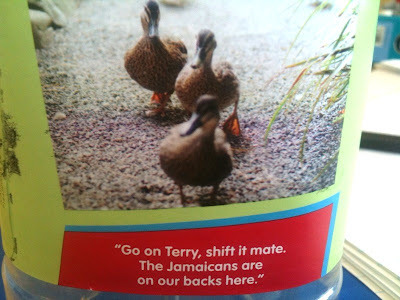
They say timing is everything in business, so Innocent
Drinks may be regretting a rather bizarre caption on one of its juice bottles.
The company, which is now majority owned by Coca-Cola,
admitted the wording on its advert hailing itself as the official juice of the
London Olympics was “pretty unfortunate” - but says it has nothing to do with
the John Terry racism case splashed across the front pages this week.
On thousands of bottles of its drinks, under the headline
“the juice of champions”, there is a picture of three ducks with the caption “Go
on Terry, shift it mate. The Jamaicans are on our backs here...”
Observers were left scratching their heads about
what it meant, with speculation it may have been a reference to the former
England captain, who yesterday was cleared of a racially aggravated public
order offence against QPR’s Anton Ferdinand, whose father is from the West
Indies.
But apparently the chatty branding was just an
ill-timed coincidence, according to a spokesman for the drinks firm.
“It’s pretty unfortunate, but we’ve actually had
this caption on our juice bottles since before that whole saga,” he said.
Seeing as Terry was first accused of the racist volley of abuse nine
months ago, Innocent were clearly well ahead in their Olympic marketing plans.
Last year, Britain’s biggest smoothie maker was hit
by revelations that it held on to £520,000 pledged to its charitable foundation
in 2007, and had not donated a penny since 2008 - despite printing on bottles
that 10% of its profits went to charity.
***************************************************
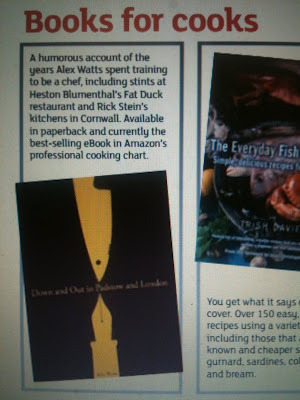
:: Little bit on my new food book ' Down And Out In Padstow And London ' in the latest issue of Essential Catering magazine.
Published on July 14, 2012 03:38
June 25, 2012
The Food They Won’t Be Serving At The London Olympics
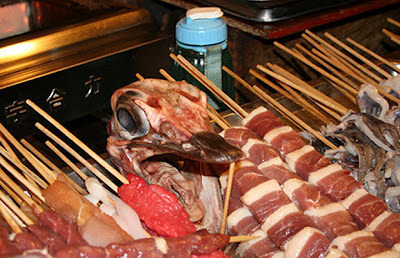
With the Olympics just a few weeks away, it appears every feature writer
in the country has been hard at work trying to find ways to nose articles on
London 2012.
We’ve had daily pieces on the stately homes, towns, former pit villages
and rough estates the Olympic Torch has passed through on its 70-day journey
around Britain. Nature writers penning columns on the 2,000 ash, alder, cherry,
willow, birch and hazel trees planted in the Olympic Park. And history nuts
casting their eyes back 64 years to the last London Olympics, when athletes
apparently travelled by bus, stayed in shabby flats, and sewed their own kit.
Then, there was rationing. Now there are trendy food markets and pop ups
on every corner, and a never ending appetite, it seems, for food and drink features
with an Olympic theme, however desperately crowbarred in. I even spotted a
journalist the other day on Twitter desperately asking whether anyone “could
think of a way of linking a feature about drink with the Olympics”.
There have been endless, clichéd articles about how British food is
trying to throw off its stodgy image of stringy beef and boiled, overcooked
vegetables with everything. Apparently, according to some food writers, the
world still sees us a culinary wasteland built on deep-fried Mars bars, instant
mash and baked beans. Where have they been for the past 20 years?
Even David Cameron has got in on the act, espousing the virtues of
sticky toffee pudding from Cartmel, oysters from Whitstable, salt marsh lamb
from North Wales, and smoked salmon from Scotland, as the key to our cultural
identity - showcasing “our heritage, openness, creativity and diversity".
He didn’t mention what he plumps for at his country suppers.
We’re told spectators will be able to enjoy roast pork on a roll, Red
Leicester cheese and apple chutney sandwiches, and, of course, fish and chips -
as well as dishes from far away places like Asia, Africa, and the Malvinas.
Roast penguin anyone? And if that wasn’t enough, the world's biggest McDonald's
in the Olympic Park. Well, they had to do something for the sponsors I suppose.
But however ethnically diverse the offerings, thankfully you won’t find
some of the foods I ate while covering the last Olympics in Beijing. In the
weeks I spent there suffocating in smog, I wrote an article on the city’s
Donghuamen night market, which the Chinese government had rebuilt to showcase
100 "dainty snacks" from all corners of China. Dainty wasn’t the word
immediately on my lips when I conducted a Bushtucker trial with tourists in the
market. Here it is, if you want a read...

I THREW up five minutes after visiting Donghuamen night market. It
wasn't the snake, or the scorpion, the lamb's penis, testicles, bees,
centipede, or the beer I downed trying to banish the taste. It was the
silkworm.
It exploded in my mouth and it was everything I could do to stop myself
instantly gagging on the musty, yellow gunk. I managed to last until the
filming stopped - and then threw up in one of the bins.
All to the bemusement of the locals, who clearly found the array of
creepy crawlies, and other things that go crunch in the night, delicious.
A sign in English said the people's government had rebuilt the market,
off Beijing's central Wangfujing Street, to showcase 100 "dainty
snacks" from all corners of China.
They said they wanted to "enhance the friendly exchanges with
foreign countries."
But when I offered the delicacies to the hordes of Olympics fans who had
descended on the infamous tourist spot, I think the most complimentary comment
was "absolutely disgusting".
Only the French seemed to like it. A gaggle crowded round the scorpion
stand and made pleasing, lip-smacking gestures in the way they would if they
were tucking into a truffle or slice of foie gras, or a frog for that matter.
The whole thing was a dreadful experience, but the politburo was right:
it did lead to some friendly - and hilarious - exchanges. I even found myself
having a new-found respect for the likes of Peter Andre and Paul Burrell.
The Bushtucker Trials on TV show I'm A Celebrity… Get Me Out Of Here
looks easy when you're munching crisps on the sofa.
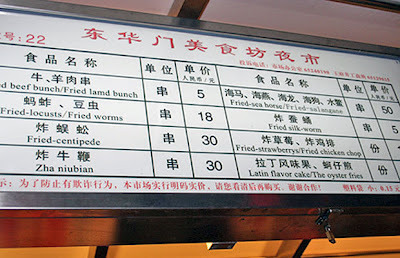
But when you get that first stomach convulsion, and insect legs stick in
your throat, and the deep-fried, rancid taste is with you for the next 12
hours, it takes a lot more guts than you think.
"What do you think of the silkworm then?" I ask Canadian Kim
Warburton, who is on a fact-finding mission for the Vancouver Games in 2010.
"It's awful. It's definitely a local taste - and it's still in my
teeth!"
Her colleague Sarah Triantafillou is having none of it. I offer her a
bit of snake, or was it a baby seahorse? But the most adventurous she'll go is
the noodles.
"What did you think of the baby eels?" I ask. "What! No
way!" she shrieks, clutching her mouth.
A Mexican guy butts in, shaking his head with a hangdog expression.
"The scorpion was interesting," he muses.
I eventually get an American, in obligatory baseball cap, to eat a
three-inch centipede. "It looks horrible, what does it taste like?"
he grimaces. "It tastes like centipede," I tell him.
He crunches away with a pained look. "It's terrible - it's as bad
as it looks. Errr centipede!" I offer him a beer to remove the taste.
"No thanks," he says. "If I drink too much beer, I might
eat another one."
:: My new book 'Down And Out In Padstow And London' about my disastrous attempt to train as a chef, including stints at Heston Blumenthal's Fat Duck, Rick Stein's and other restaurants, is available as a paperback and eBook on Amazon CLICK HERE
Published on June 25, 2012 10:02
June 19, 2012
The Hand And Flowers: Can A Two Star Michelin Eatery Really Still Be Called A Pub?
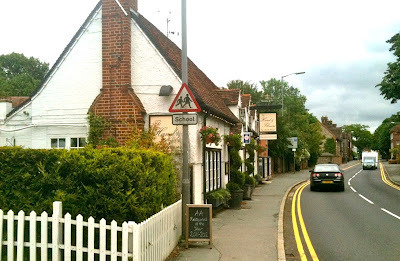
I’d been wanting to go to the Hand And Flowers for a long time. The last time I’d drunk there was as a youth, when it’d been an unassuming country pub perched on the fringes of an upmarket town, and I’d thrown up in the garden. But, unlike me, it’d done a lot of growing up in that time, and was now a two-star Michelin eatery owned by fast-rising celebrity chef Tom Kerridge.
So a few days after returning from my 17-month sojourn in SE Asia, I drove to Marlow in Buckinghamshire to try out the grub. As I walked up to the front door, I was delighted to see Kerridge dealing with a van driver in the car park. The 38-year-old cook appeared rather red-faced and stressed - much more chef-like than the relaxed, smiley-faced man who stole the show on the BBC’s Great British Menu.
The fact that he was there at all, not just propping up the bar signing menus and regaling customers, but actually in whites cooking in his own kitchen, spoke volumes. Compared with the number of absentee sleb chefs you get in restaurants these days, it was a hugely refreshing sight knowing he would be behind the stove, driving on his team of nine cooks in his newly-enlarged kitchens, rather than flouncing around in front of cameras.
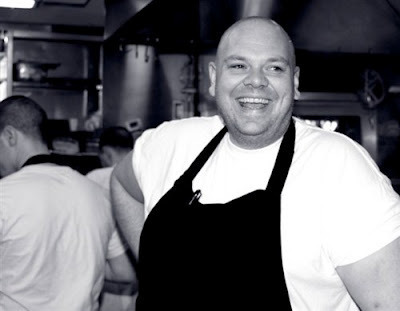
But as it turned out, he’d just returned from a three-week jolly to Singapore, where he’d been showcasing British pub food with his sous chef. I don’t know who’d been covering for him, or whether standards had slipped in his absence, but I was glad to be eating there when the big man was behind the stove, even if he did look a touch jet-lagged and frazzled.
The venue is hailed as the only pub in the world with two Michelin stars...but hang on a minute. Pub? Alright, it serves draught beer, has a bar, and is decked out in dark wood, but surely a pub is somewhere you drink ? Somewhere you can order beer without anything more than crisps, cockles, or pork scratchings and not get frosty looks? It’s not a place that sells bottles of 1995 Chambolle-Musigny 1er Cru Amoureuses, Dmne Roumier for £1,100, or have I been away too long?
For me, there’s an easy test. If you can drink there happily without having to order grub, it’s a pub. If you can’t, it’s a restaurant. So the Hand And Flowers definitely isn’t a pub. I mean, there’s a line at the bottom of the menu saying minimum spend £15. You wouldn’t get that in a proper pub, would you?
So just to check, I gave them a ring, pretending I’d just moved into the area and was checking out the local venues. Could I have a drink in there without buying food, I asked, expecting an immediate: “No, of course not. Fuck off.”.
I was wrong. The manager seemed quite well versed on the subject, schooled even. She said I was welcome to have just a drink. But only if I was standing at the bar, or standing or sitting in the garden. In short, the only way I could sit down without being rained on was by ordering food. So that’s settled - the Hand And Flowers IS a pub and is quite correct when it describes itself as “the first pub to have been awarded two Michelin Stars”. I just don’t know anyone who’d want to drink there. Five minutes of being jostled by never-ending waiters would be enough.
But as it turned out, I ate at the bar anyway. I’d booked the day before, and the only free table was at 2.45pm.
“Isn’t there anything earlier?” my dining companion asked, so I tried again.
The manager, who’d clearly forgotten about space needed for drinkers, said I could have a table at the bar at 12.45pm, 1pm, 1.15pm, 1.30pm...and presumably would have gone right the way through the afternoon at quarter of an hour intervals, until I said 1pm was fine.
So there I was. Kerridge looking red-faced dealing with a supplier in the car park. Me sat at the bar in candle-light. It’s for this reason, I have to apologise for the very poor quality of these photos. The place was so dark, it was like eating in a mine shaft.
I ordered a pint of Greene King IPA, and my dining companion went for a similarly splendid gin and tonic. You might think there’s little that can go wrong with a gin and tonic, but apparently not. And there must be something in it, otherwise Michelin inspectors wouldn’t test the quality of a restaurant’s, sorry pub’s, beverages by ordering orange juice (is it freshly-squeezed etc) and a G&T (don’t ask).
Although the choice of items on the a la carte menu sounded fantastic - crispy pig’s head with rhubarb; loin of Cotswold venison with ox tongue; parsley soup with smoked eel et al - we went for the set lunch menu of two courses for £15, or three for £19, because I was paying. I was also intrigued how they’d pull off two-star cooking at the price of an all-you-can-eat Sunday curry buffet.
A plate of “free canapés” quickly arrived, delivered in a bounteous fashion as if they were a special favour for us. But it turns out they do this for everyone. A couple of slices of delicious bread, tiny saucers of flaked salt and freshly-cracked pepper, and a fish and chip-style cone of whitebait in a wonderfully light batter.

The cone arrived on a wooden board next to a small pot of Marie Rose sauce - which was as bad a match as it was made. Why anyone would want to dip whitebait in prawn cocktail sauce is beyond me. But when it’s the sort of pedestrian mayonnaise and over-riding ketchup flavour you’d expect from a James Martin airline meal, it’s far harder to stomach. But perhaps I’m being too harsh? They were “free canapés” after all.
The next blip was the “cauliflower soup with potato pakora and curry oil”. Cauliflower soup is never a particularly brilliant dish, for my money, but it works best when it’s done simply with just cauliflower and stock. This one was so drenched in cream, the cauliflower was left peeking out like a pervert in a Soho booth.
The soup was topped with a huge and deliciously-spiced pakora. But where was the curry oil? Normally you can’t miss it, because chefs can’t stop themselves doing fancy patterns with squeezy bottles. Then came the question of how to eat it. Do you dip the pakora in the soup? Or wolf it down, then get to the soup? Or sink it and eat spoonfuls of pakora and soup?
I went for the latter, and clearly this wasn’t the right way because as soon as I put my spoon down for a second, mid-bowl, the waiter - obviously noticing there was no longer a massive pakora terrifying my broth - snatched our plates away.
“Finished our soups gentlemen?” he said, not waiting for an answer. “How were they for you?”
Normally, I’d be annoyed. But I was pretty much creamed out by that stage. And it was the only fault in the otherwise excellent service. Sadly, in many Michelin-starred restaurants, or far worse prissy restaurants overlooked by the tyre guide, the service can be so affectedly solemn it leads to the sort of constipated atmosphere that does little for the indigestion.
But it was just right at the Hand And Flowers. The Dereks were friendly and relaxed without too much pushy, while being extremely professional and attentive throughout. The only exception was the soup snatcher with the silly hair. But there’s always one.
Next came “belly of Wiltshire pork, spring turnip puree with marmalade and Italian leaves” - which was an absolutely sensational dish. Kerridge is known for his pork, and this showcased every bit of his talent. It was quite simply out of this world. It wasn’t the most generous portion of meat, but what do you expect at that price?

The belly, garnished with kohlrabi shoots, was juicily moist, and the skin beautifully crisp. It was perched on grilled and pickled endive, which was wonderfully bitter, and balanced the sweetness of the turnip puree and marmalade. The toffee-coloured gravy was divine, and having worked in a couple of Michelin restaurants , I can only guess at the fuss that had gone into creating it. Almost as good were the tiny copper saucepans of pomme boulangère we ordered from the sides to go with it. It really was a wonderful plate of food.

We were asked if we wanted desserts, but settled for coffee. I was tempted by the wonderful looking cheese board perched near my elbow - camembert, Wookey Hole Cave aged cheddar, Golden Cross, Barkham Blue, and the strongest of them all, plaisir au Chablis - a cheese from Burgundy washed once a week in wine.
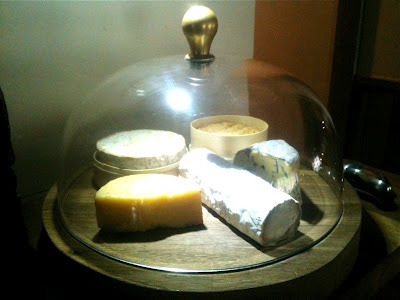
Overall, it was a very relaxed, charming place to eat with brilliant service. And perhaps it’s unfair to judge a restaurant, sorry pub, by its lunch menu, but if it hadn’t been for the brilliance of the pork dish and boulangère side, I could have shut my eyes (or blown out the candles) and imagined myself in any one of the thousands of mediocre gastropubs that have spawned across Britain. I'd need a lot more convincing to accept it's the best one of the lot.
:: My new book 'Down And Out In Padstow And London' about my disastrous attempt to train as a chef, including stints at Heston Blumenthal's Fat Duck, Rick Stein's and other restaurants, is available as a paperback and eBook on Amazon CLICK HERE
Published on June 19, 2012 04:22
June 10, 2012
An Expat Returns: Food I’ve Missed - The Good Old British Pie

I
mentioned in my last blog that I’d write up some of the meals I drooled over in
the 17 months I spent living in hotels in SE Asia , with only a kettle to cook
in. And at the top of the list, or thereabouts, was the good old British pie.
What
would I cook first, now I had a kitchen again? Steak and kidney pudding?
Chicken and mushroom? Minced beef and onion? A proper pork pie or Cornish pasty ? Or how about one from The English Cookery Book by Lucie G Nicoll I’m
re-reading? A curiously quirky and charmingly vague book that for the second
season of the year (April, May, June - if indeed it is early summer now, and not
late autumn which the weather seems to suggest) recommends May Pie - an
unspecified pastry filled with stewed young onions, turnips, carrots, lettuce
hearts, parsley, and green peas in gravy. Or salmon pie - which is more of a
baked fish loaf than a pie - containing just milk-soaked breadcrumbs, salmon,
butter, seasoning, and beaten egg.
To
be honest, neither was what I was imagining in those long evenings supping iced
beer while discussing the merits of meat pies with Kiwis - a people that seem
to hold the crumbly, fat-soaked comfort of flesh and pastry in even higher
esteem than the Bovril-swigging English football fan.
In
fact, I had to go back to the first season of January, February and March (who
said the seasons aren’t changing?) to get on to the good stuff like beefsteak
and kidney pudding made with nothing more than rump steak, beef kidney, flour,
and ‘suet paste’. Or calf’s head pie made with head stock and meat and boiled
eggs. Or Fanny pie comprising beef, mutton, bacon, onion, carrot, potato and ‘rich
paste’. Or how about vermicelli pie, mutton pie, or bacon and herb pie?
No,
I’d make it my own way from whatever needed using up in the fridge and freezer -
in this case three chicken breasts and a bag of 18-month-old frozen leeks - a
concoction which with a midnight plunder of next door’s herb garden became ‘chicken and leek pie in tarragon
pastry’.

And
I have to say I was really chuffed with the result. It was so filled with herbs,
it sort of stumbled drunkenly on the tongue in a heady bouquet, like sage derby
on a few crackers. And although I’d made up the tarragon pastry on the spot, it
turned out crispy, delicious and thankfully golden despite the unappetising
green colour before it was cooked.
Anyway,
enough talk. Here it is. It’s really worth a go - especially if, like me,
you’ve been pie less in a pie-filled world for far longer than you’d care to
recall.
Chicken
And Leek Pie In Tarragon Pastry
For
the filling:
A
little butter and olive oil for frying
3
shallots, finely chopped
2
sticks of celery, peeled, cut into four lengthways, and then diced
2
garlic cloves, finely chopped
2 leeks,
washed well and sliced
3
thyme sprigs, chopped
3
chicken breasts, cut into 2cm-wide cubes
1
bacon rasher, thinly sliced
50g
butter
50g
flour
300ml
milk
1/4
nutmeg, freshly grated
salt
and pepper
For
the pastry:
300g
plain flour
150g
lard
1
level tsp salt
Leaves
from 3 tarragon sprigs
130ml
of cold water
A
greased pie dish, 8 inches wide and 2 inches deep
Melt
a knob of butter and a splash of olive oil in a pan and fry the shallots for a
couple of minutes until they are slightly browned. Add the leeks, garlic and
celery and fry for another few minutes, stirring frequently to stop the mixture
catching.
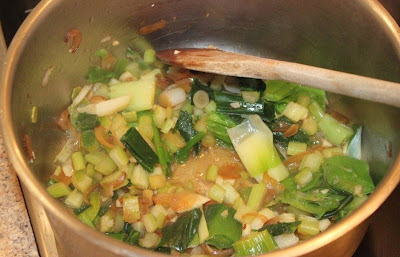
Add the bacon and chicken breast. Lower the heat, and continue
cooking for another 10 minutes, stirring occasionally.
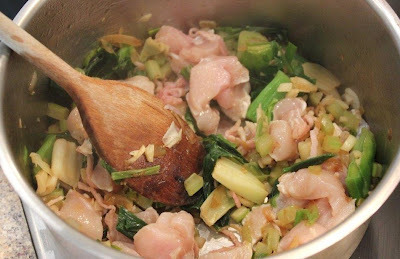
Meanwhile,
make the pastry by putting the flour, tarragon, salt and lard in a food mixer
and pulsing until it resembles greeny-grey breadcrumbs. The amount of water you
add will depend on how much moisture was in the tarragon. Mine took about 130ml
of water. Continue pulsing the breadcrumbs while trickling in the water. Stop
when the pastry forms a ball and comes away clean from the sides of the processor.
Cover with clingfilm and put in the freezer to chill.
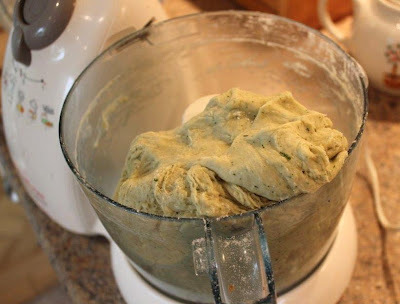
Add
50g of flour and the freshly grated nutmeg to the pie filling and stir well for
a minute over a low heat. Slowly add the milk, making sure each splash is fully
blended in before adding the next one. By the end, the sauce should be the
consistency of thick custard. If it’s too thick, add a little water. Continue
simmering for another five minutes, stirring all the time, then take off the
heat. Add the chopped thyme and season with salt and pepper.

Remove
the pastry from the freezer and knead a couple of times on a lightly-floured
board. Take two thirds of the ball, flatten into a disc with your hands, and
roll into a circle about three inches wider than the pie dish.
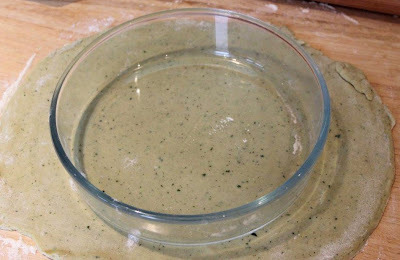
Drape the pastry
circle over the rolling pin, and then line the heavily-buttered pie dish. Push
down gently to make sure there are no air pockets. Trim the pastry from the
sides.
Roll
out the excess pastry until about 5mm thick. Cut into strips. Brush the trimmed
pastry edge with water and lay the strips on the rim of the pie dish and gently
press together. Brush the pastry rim with water. Fill the pie with the creamy
chicken and leek filling.
Roll
out the remaining pastry to fit the top of the dish, and press the pastry edges
together. Cut round the dish to remove the excess pastry, and then squeeze the
edges together with a fork. Roll out the surplus pastry and cut into leaf
designs to decorate the pie.
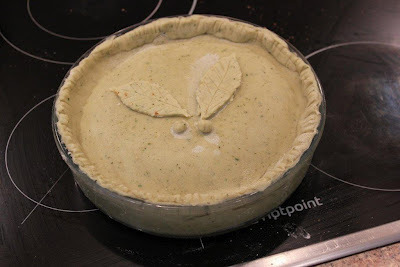
Brush the pastry with egg yolk. Pre-heat the oven
to 180C and bake the pie for one hour, or until a beautiful golden brown
colour.

:: My new book 'Down And Out In Padstow And London' about my disastrous attempt to train as a chef, including stints at Heston Blumenthal's Fat Duck, Rick Stein's and other restaurants, is available as a paperback and eBook on Amazon CLICK HERE
Published on June 10, 2012 08:59
June 7, 2012
Panic Buying Of Bunting And A Rant About The Jubilee

After
17 months in Asia, I have finally returned to the UK and it’s been quite a
culture shock as I suppose I always knew it would be. “How are you going to cope
with being back here?” concerned friends and relatives asked. They answered the
question themselves before I could. “You’re not. Are you?”
Well,
I have no idea, if the truth be told. I arrived just in time for the Diamond Jubilee
celebrations. Festivities would be too strong a word. I went to my parents’
village fete, which was opened by actor David Jason, who lives down the road,
and watched the egg and spoon races and drank the awful summer bitter supplied
by Chiltern Brewery.
Then
I watched the military parades put on by the Army, RAF and sea cadets, and took
a couple of pictures of Del Boy posing with the Royal British Legion Riders
Branch, hoping the snaps might get into one or two of the papers. I could see
the headline already “Lovely Jub-i-lee” - and wrote how the Only Fools And
Horses star had swapped his grubby three wheeler for a shiny Harley Davidson.
But
what struck me most was the massive difference between Asian culture, particularly
in Cambodia , where I spent most of my months in SE Asia, and the floral-knitted
lifestyle enjoyed in Britain. It seems far more tediously pedestrian than when
I went away, not that it has probably changed that much however badly the
country’s been run by Dave and his pasty-eating chums.
Of
course, there are many things wrong with Cambodia - abject poverty, corruption,
the complete lack of free education and healthcare, not to mention the impunity
of officials able to gun down protesters who have the temerity to ask for
little more than a slight improvement in their atrocious living standards. By
comparison, the pasty tax is a tiny cold sore on the moon’s face.
But
there are many things the country does much better than Britain, and perhaps
the most noticeable of these is having fun. I think people here have forgotten
how to do it. It isn’t just the terrible weather and the obsession with it -
newspapers banging on about the Blitz spirit and how a million people lined the
Thames, braving life and limb in monsoon conditions to cheer on the Queen - it’s something far more depressing and
mundane. You can’t blame it all on sodden spirits and the icy grips on
umbrellas, it’s what passes for having a good time these days.
Just
how did people celebrate this historic, patriotic occasion - and more
importantly an extra day off from the soul-destroying office? They waved flags
and held garden parties, and got local celebrities they never see for the rest
of the year, to open village fetes. Some even held jam competitions and rode ponies.
But nowhere, from what I could gather from idiot TV presenters interviewing
people around the country about what the Queen means to them, did anyone seem
to be having any fun. Nothing even close to it.
After
Del Boy had done his stuff and tottered back to his mansion in his huge wellies,
people gathered outside the village hall for a pig roast. And how did they
enjoy this porky feast? They formed a huge queue, as only the British can. Few
people spoke, no-one mingled, they just looked at the queue snaking away in
front of them and wondered whether there would still be some meat by the time
it was their turn to bung some apple sauce in a floury bap.
I’ve
seen street beggars in Phnom Penh having more fun with a flat can of coke. It
was sad to see. And for me, it largely comes down to community spirit. Or the
complete absence of it. Here, villagers live a few yards from each other, just
like Cambodia - and yet no-one knows who anyone is. It’s all about the fact they
get in little boxes to drive to work, then work in bigger boxes, and then return
in their little boxes for an evening in front of an even smaller box, which is why
so many pubs are closing. And the only interaction they have is when a planning
application is submitted and they get hot under their NIMBY collars and worry
about how the extra homes or high speed rail link will affect property prices.
There’s
tangible fear everywhere. Fear of breaking tedious bylaws and being seen to do
wrong. Fear of being themselves. Fear of actually enjoying themselves. You
might disagree. You might think what does this idiot know. We had a tug of war
in our village, a cow pat-throwing family fun day, and a nettle eating
competition. It was great fun.
But
it really struck it home to me after the pig roast when everyone drove up the
hill to light the beacon and listen to a jazz band in the icy rain. After frets
about where you’d park and warnings from the local cadets about if you left
your car on the road “it was at your own risk”, people tramped over the hill to
watch 25lb cannons being fired, and silently prayed one of them might hit that
terrible eye-sore of a garage their neighbour had built (we’re sure without the
relevant fire certificate and building regulations). Then it was time for the
fire to be lit.
You
could see where it was despite the darkness and horizontal rain because there
was a huge fire engine and a dozen firefighters ready to jump in should the
burning crates get out of hand and somehow set fire to the sodden hillside. Or
perhaps they were worried some Royalist madness might take over and people
would start burning suspected witches? Not that you could really get much of a
view of the fire engine because you had to stand well behind a safety cordon at
least 100 yards from the action and imagine the warmth of the flames from
there, and how wonderful it would be to chuck in a couple of foil-wrapped,
ambient spuds.
One
of my last memories of Cambodia was a three-day village party - this time not
in celebration of a Royal anniversary, with the ensuing panic buying of bunting,
but because they wanted to - with a spit-roast calf and a fire in a nearby field.
There was no safety cordon or fire crew ordering you where to stand, or little
sergeant majors telling you to cover your ears when the cannons went off, or ‘safe
areas’ for the fireworks. Or even any queues for that matter.
There
was just the chaotic enjoyment of the good things in life, and bottles of
Mekong whisky being passed around until people got into such a state of happy oblivion
they’d not so much forgotten to worry about whether the Volvo with its tucked-in
wing mirrors would be safe on the grassy verge, but that they had one at all.
I
remember a four-year-old boy clutching a handful of fireworks as his father lit
them. Proper ones too. Bang, they went, and lit up the sky. No-one died, no-one
got injured, but everyone had a good time. As I say, there are many things
wrong with Cambodia, and there are many laws needed there that would desperately
improve people’s lives, but we’ve gone far too far the other way until the very
essence of life has been throttled out of us in perfectly-trimmed suburbia.
Yes,
you can still find places in this ridiculous nanny state where people still enjoy
themselves, but it’s a shame what this country has become and how any sense of
community spirit has long vanished.
Anyway
this rant is over. As I slowly get used to the appalling summer weather here
again, I’ve been cheering myself up by cooking all the dishes I’ve missed living
in hotels for the past 17 months, with only a kettle to cook in , which I’m going
to post here over the next few days. Who said life isn’t fun?
:: My new book 'Down And Out In Padstow And London' about my disastrous attempt to train as a chef, including stints at Heston Blumenthal's Fat Duck, Rick Stein's and other restaurants, is available as a paperback and eBook on Amazon CLICK HERE
Published on June 07, 2012 18:34
May 22, 2012
Cambodian Food: Top 11 National Dishes
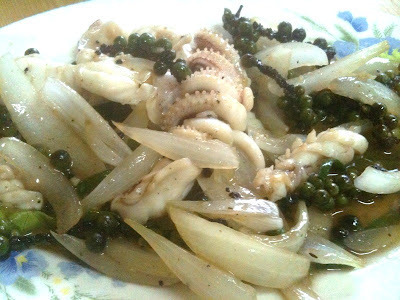
I’ve just booked my ticket home to the UK after more
than a year in Cambodia, and I still think I know less about the food than when
I first got here. In truth, I’ve barely even scratched the surface of Cambodian
cooking. I’ve not eaten every dish this beautiful country has to offer, far
from it, and sometimes when I go to a new province I’ll find a dish that I’ve
never even heard of.
My research hasn’t been helped by the fact that
there are only a handful of books on Cambodian food, and only a couple of blogs
worth reading. But I wanted to give you a list of dishes you should try if you
do come here - the ones that really made an impact on me.
I began this blog scribbling in a roadside cafe in
Phnom Penh, and tried to draw up a list of my top 10 Cambodian dishes. It
wasn’t easy. I don’t mean finding ten, I mean whittling it down from the 20 or
so I’d scrawled into my Moleskin notebook.
Which ones would I leave out? Would I shove in a
couple of desserts for balance, or just the ones I liked best? In the end I
settled for 11 dishes - I couldn’t see a way of cutting it down to 10 and I still
had to leave out some excellent ones like squid with green Kampot pepper (pic above). So
here goes...
1. Cambodian Beef Soup
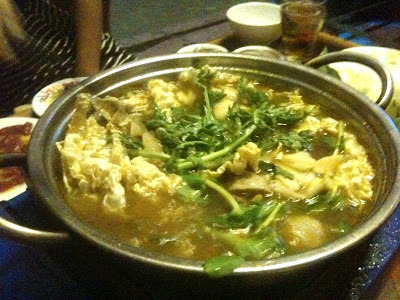
This is a great dish and one of the best communal
meals I’ve ever had. Cambodians love eating - they graze all day - and are very
passionate about food. And I love the arguments that develop about whether, or
when, the noodles should go in, whether the thinly-sliced raw beef fillet
should be mixed with beaten egg first. And how long should it poach for? Forty
seconds? There are few finer things in life than friends
sitting around a table squabbling about food while topping themselves up with
endless jugs of beer.
It begins as a bubbling bowl of beef stock
containing chunks of tougher cuts that have been cooked until they dissolve in
your mouth in a pleasing squelch of fat and gristle. The bowl is put on a gas
burner on the table and so many side plates appear that there is hardly room
for the beer jugs.
There are plates of vegetables, fresh herbs like
mint, holy basil, and culantro (saw-toothed coriander), a couple of raw eggs, beef
fillet, yellow balls of egg noodles, white balls of rice noodles, chillies,
prahok , lemongrass, salt and always Kampot pepper. So many in fact that you
could probably order the dish 100 times and never have it the same way twice -
depending on who’s doing the cooking that is.
2. Prahok Ling
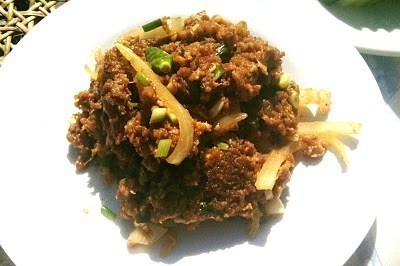
This is an incredibly powerful dish, flavoured with Cambodia’s
notoriously foul-smelling fermented fish paste, prahok. The paste is fried with
hand-chopped pork, onion, garlic, egg, and chilli.
And it’s so strong there are strict Government laws
in place to ensure you only get a small saucer of the stuff, which you eat with
boiled jasmine rice and chunks of raw aubergine, cucumber, green tomato, and white
cabbage to take the edge off the extremely pungent taste.
I’ve always been into bold, salty flavours, and for
me it’s absolutely delicious, but it wouldn’t suit everyone. Recipe here ...
3. Spit-Roast Calf (Koo Dut)
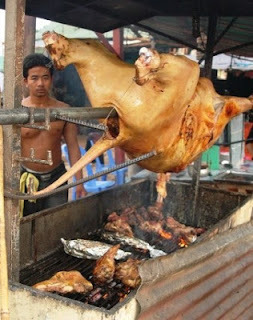
When I first got here, you used to see whole calves being
slowly cooked in the street, and what a lovely sight it was too. But a couple
of months ago, the Cambodian government, in its wisdom, decided to ban restaurants
and stalls from spit-roasting cows in public – over claims they incite violence
and are bad for the image of Cambodia.
Now you won't see a spit-roast calf on display
anywhere in Cambodia (they're being cooked in kitchens and yards at the back). But
although the theatre has gone, and Phnom Penh’s stretch of koo dut restaurants
are noticeably quieter as a result, it’s still a dish worth trying.
The hunks of grilled veal are always served the same
way, with a tray of crudités, salt, pepper and lime dip (tuk meric), and prahok
sauce. The cooks get to work early in the day by butchering and washing the
carcass, and then filling the belly with lemon grass, lime leaves and rice
paddy herbs before sewing up the cavity. The beast then slowly spit-roasts for
hours over charcoal and wood.
4. Salt, Pepper And Lime Dip (Tuk Meric)

Tuk meric is an incredibly simple dip made from
salt, Cambodia’s wonderful Kampot pepper, and lime juice. But my God it works.
You’ll get it with everything from hunks of barbecued calf to Cambodia’s
horrendous beef lok lak, a version of Vietnam’s far better dish of the same
name.
But it goes best with freshly-boiled seafood,
particularly blue swimmer crabs, which although contain little brown head meat,
and virtually no morsels in the claws, more than make up for it with the
generously fleshy chine.
In restaurants, they usually serve a mix of two
thirds freshly-ground black pepper to one third salt, then carefully squeeze in
two or three lime quarters and mix it in front of you. It might seem a laughably simple procedure that
would scarcely trouble even the most cack-handed cook. But they take it as
seriously as a chef de rang would the preparation of crepe suzette, pressed
duck, or table-carved rib of beef, squeezing in the ‘correct’ amount of lime
juice until there is the right moistness to the sauce.
You’ll have few better days than sitting at a
restaurant in Kep’s famous crab market, looking out to sea, while supping cold
beer and dipping freshly-boiled crab into this incredible dip.
5. Khor Trey Swey Kchey

This is freshwater fish braised in a mildly-spiced
palm sugar sauce with grated green mango on top. I’ve had the dish a few times
and it’s wonderful.
It sums up the rustic nature of Cambodian food - the
contrast of the different flavours in the dish rather than how balanced it is -
a common feature in cuisines that haven’t been refined.
There’s a delicious
combination between the sweetness of the fish, and its sticky, slightly
caramelised sauce, and the very sour green mango on top with the herbs, and
then the crunch of raw vegetables like green tomato and cucumber.
6. Chicken And Salted Lime Soup
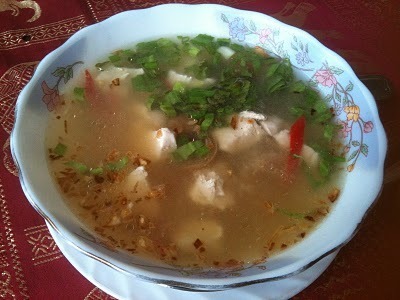
This is traditionally served at weddings out here,
but is actually of Chinese origin - a country that has probably had the biggest
influence on Cambodian food.
Ngam ngov (salted limes) were brought to Cambodia by
Chinese immigrants more than 700 years ago. The limes are dried in the sun and
then stored in brine, so they soften and take on an incredibly sour, slightly
soapy flavour.
The duck or chicken is deep-fried and then cooked in
water flavoured with kaffir lime leaves, galangal, lemon grass, garlic, fish
sauce, and the salted limes. Generally, the limes are used in soup, but you
sometimes find them chopped up in Chinese-style stir-fry dishes, usually with strips
of chicken and herbs. Recipe here
7. Chicken Porridge Soup
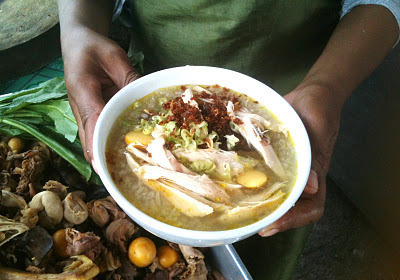
Cambodia is truly the land of soups. I don’t think
you’ll find a country with such a high proportion of soups on restaurant menus,
and there is nearly always a broth at every family meal. But of all the great
broths in Cambodia, and there are plenty, chicken porridge soup ( bo bor sachmoan ) is my favourite.
It’s traditionally eaten at breakfast and topped
with nutty, browned, but not burnt garlic, and the herby fragrance of chopped
culantro. As you dig in, there is the occasional limp crunch of bean sprouts
poached in the heat of the broth, and the pleasing discovery of a little piece
of chicken or bone to suck on.
Then there is the chicken stock, hinting of lime
leaf and lemon grass, and julienne strips of fresh ginger that are, like the
bean sprouts, stirred in at the end moments before service so they take on an
increasingly cooked texture as you finish the soup.
Then there’s the soapy richness of the cubes of
blood pudding, made from pork and chicken blood, and the yolks taken from the
hens' ovaries, which glint like amber pearls. I could go on...
8. Fried Pork With Chilli, Lemon Grass And Holy
Basil
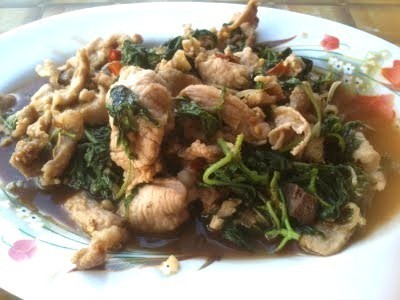
Generally, Cambodians don’t use too many chillies in
their food, the same way as say Thais do. Instead, they serve it separately –
usually sliced chilli in a saucer, pickled tiny chillies in a jar, and a fiery
relish of sliced red chillies and garlic, so people can put as much on as they
want.
But this brilliant dish helps destroy the popular
myth that Cambodian food is never spicy. I’ve tasted the dish in many
restaurants and homes, and it’s always eye-wateringly hot - just like the green
mango, papaya, and Khmer beef salads they serve, particularly in the Battambang
region.
A huge handful of holy basil is thrown in, and cooks
down like spinach. Its clove-like taste works well with the chopped fresh and
dried chilli, and gives the dish a deep, spicy flavour, which is lightened by
the zesty, perfumed taste of lemon grass - an integral ingredient to Khmer
cuisine.
It needs no accompaniment, other than a soup, a bowl
of sticky rice, and a kettle of cold tea poured into a mug of ice and drunk
through a straw.
9. Cambodian Dried Fish Omelette
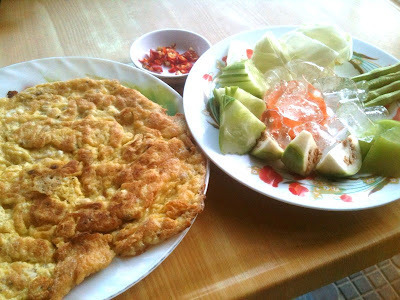
The best version I had was made with smoked fish
that had been soaked in brine, and then grilled over smouldering wood for eight
hours until they were hard and chewy. But mostly salted, dried fish are used.
The fish is broken up into small pieces and then
added to a pan with chopped onion and garlic and fried for a couple of minutes.
A couple of beaten eggs and black pepper are added, and the omelette is served very
thin and dry with a plate of raw vegetables and rice. It makes a very savoury, rich
breakfast.
10. Samlor Ktis
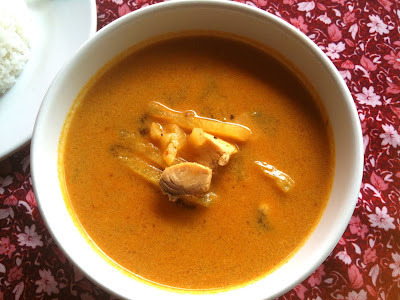
This is one of the many sour soups you’ll find in
Cambodia, and is incredibly easy and quick to make. But like most good dishes,
its strength lies in its simplicity.
It’s usually made from fish or chicken and flavoured
with chunks of fresh pineapple, Cambodia’s mild kroeung curry paste, and coconut
water - an almost colourless liquid found in young, green coconuts. It’s
amazing the fresh, clean flavour achieved from just a handful of ingredients. Recipe here ...
11. Grilled Pork With Rice And Pickles
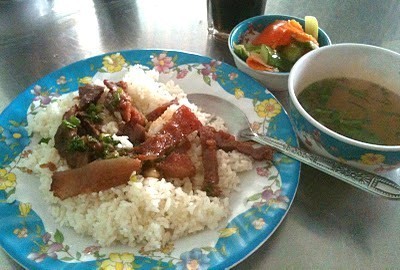
This has become one of my favourite breakfasts. There’s
something incredible in the way the pickled vegetables, chewy slices of grilled
pork, and the pork and chicken broth work together with pickled chillies from
the condiment trays to make something amazing.
The pork is marinated for hours and then slowly
grilled. It has such a deliciously salty flavour and intense red colour that I
can’t get enough of it. You pour spoonfuls of the clear broth over the rice and
pork and then dig in.
The pickle is usually made from carrot, cucumber and
daikon. They are cut on a mandolin into julienne strips and then salted. The
water produced is drained off and then they are soused in a pickling mixture of
water, white vinegar, sugar, salt and spices. Think kimchi without all the PR.
MORE: Cambodian Food: The Chef Hailed As A Genius By Raymond Blanc
:: My new book 'Down And Out In Padstow And London' about my disastrous attempt to train as a chef, including stints at Heston Blumenthal's Fat Duck, Rick Stein's and other restaurants, is available as a paperback and eBook on Amazon CLICK HERE
Published on May 22, 2012 08:12



